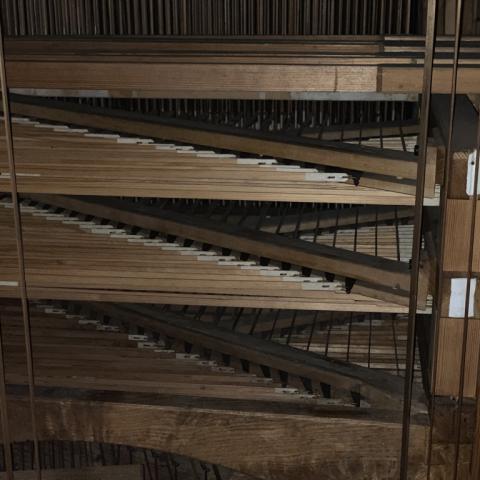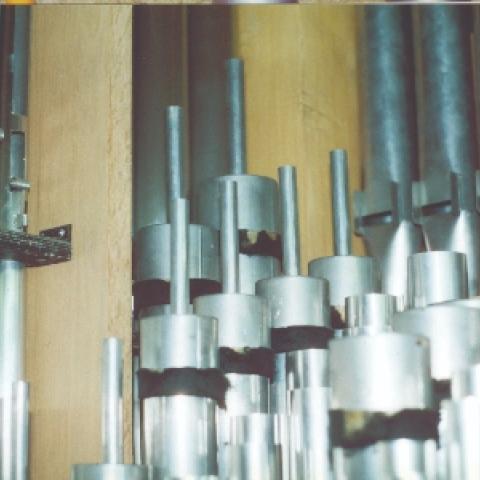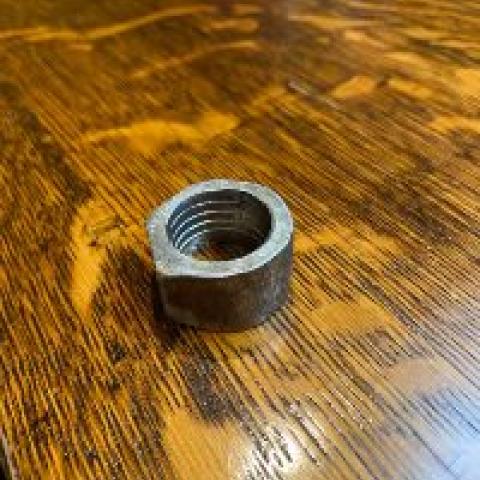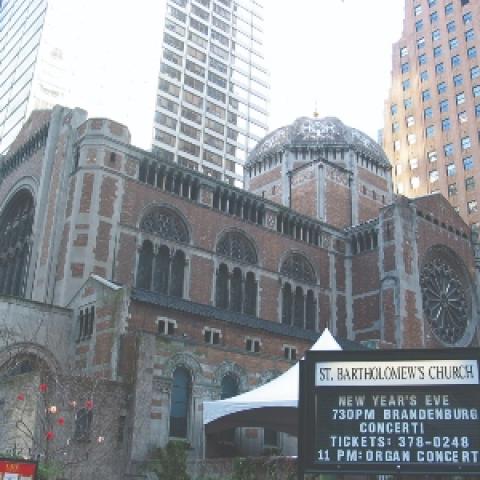
Thar she blows.
In the July 2023 issue of The Diapason, I shared that Wendy and I sold Kingfisher, the twenty-two-foot Marshall Catboat on whom we had more than ten seasons of special fun and adventure taking week-long cruises up and down the Maine coast, overnight sails to anchor in island coves or to friends’ houses for stayovers, and daysails with friends and family. Wendy and I worked hard with the decision because it meant giving up a special part of our lives, but we agreed to call it a wonderful chapter and move on to other things.
As it turns out, the summer of 2023 was a terrible time for sailing in Maine. People around here were joking that it had rained twice here this spring and summer, once for thirty-five days, and again for twenty-seven days. We sat watching the rain saying, “Sure am glad we don’t have a boat in the water this year.” And more profound, at least to me, in the last week of July I had surgery to repair torn rotator cuff muscles. An MRI showed two muscles separated from my shoulder, and the surgeon’s paperwork referred to a “massive tear.” My right shoulder started hurting last summer, and I know that handling the five-to-one mainsheet on Kingfisher had something to do with it.
I grew up singing a whimsical folk song based on a poem by Charles E. Carryl (1842–1920), set to music by Joseph B. Geoghegan (1816–1889). It was always close to the surface when we were sailing:
A capital ship for an ocean trip
Was “The Walloping Window Blind,”
No gale that blew dismayed her crew
Or troubled the captain’s mind.
The man at the wheel was taught to feel
Contempt for the wildest blow,
And it often appeared, when the
weather had cleared,
That he’d been in his bunk below.
So, blow ye winds, heigh-ho,
a-sailing I will go.
I’ll stay no more on England’s shore,
so let the music play-ay-ay—
I’m off for the morning train
to cross the raging main,
I’m off to my love with a boxing glove
ten thousand miles away.
There are five more verses, each sillier than the last.
§
I am back at my desk, the fingers of my right hand poke out of the sling toward my laptop. I have recently had several conversations about large organ blowers with colleagues and clients, and I am thinking about organ wind. In July of 2021, Aug. Laukhuff GmbH, then the world’s largest supplier of pipe organ parts, went out of business. For many American organ builders, Laukhuff was the “go to” source for electric organ parts like slider motors, pallet pull-down magnets, drawknob motors, and keyboard contacts. Their catalog included thousands of widgets for building tracker actions like squares and roller arms, and Laukhuff was one of the most important sources of organ blowers.
Laukhuff blowers are found in hundreds of organs built or rebuilt in the last fifty years. They are quiet, reliable, and compact. Along with blowers built by the Swiss supplier Meidinger, they were a technological revolution. We are all familiar with the hulking subterranean roaring monsters that blow wind for organs built before 1950. I am not sure just when blowers started getting compact and quiet, but I am certain that the advances in the technology of fan blades that brought us jet engines and modern turbines are related. The legendary test pilot Chuck Yeager broke the sound barrier flying the Bell X-1 aircraft on October 14, 1947. It took a decade or two for that to translate into more efficient organ blowers, but I know they were ubiquitous by the time I got into the trade in the 1970s.
Organists from Praetorius to Dupré relied on human power to operate the bellows of their instruments. While playing the music of Buxtehude, Bach, and Mendelssohn, do we forget that those masters had to round up people to pump organ bellows to play even a single chord? Max Reger died in 1916, so we can assume he played organs with electric blowers later in his short life, but much of the grand, dense, complex organ music he wrote predated the electric organ blower.
Marcel Dupré wrote of a Sunday in 1919 when Claude Johnson, the chairman of Rolls-Royce, was visiting the organ loft at the Cathedral of Notre Dame. While Dupré was playing at full organ, the crew of pumpers fizzled out, and the wind supply died. Johnson quickly offered to donate an electric blower, telling Dupré to have the firm of Cavaillé-Coll draw up plans, but adding that they had better get permission from the cardinal archbishop since Johnson was an Anglican.
I have long loved and often written about the thought that Widor was organist at Saint-Sulpice in Paris from 1870 until 1933, and while I do not know the actual date, an electric blower must have been installed there around halfway through his tenure. Imagine playing that mighty organ for thirty-five years relying on human pumpers and climbing the stairs to the storied loft for the first time to flip a switch and play the organ alone. Remember that huge body of organ literature that are his ten symphonies were written before 1900. Twentieth-century organists have been able to take the luxury of unlimited, uninterrupted practice time for granted.
Blower hygiene
It is common to find modern high-speed blowers ensconced within an organ case, which is only possible because they operate so quietly, but the old-time machines are typically located in remote rooms in basements or towers because they are so noisy. Ideally, those rooms are kept locked so unknowing, unauthorized people cannot get in, which means they get dirty and fill up with spiderwebs and other signs of critter life. The air intake for a blower should have a particle filter to ensure that no debris gets sucked into the organ’s interior. Sometimes we find that mounted on the door to the blower room. A fleck of sawdust or a carcass of a fly is enough to stop a reed pipe from speaking, to cause a cipher if it winds up on the surface of a valve, or a dead note if it clogs a windchest magnet. How would a fleck wind up there? Follow the air flow from the blower, through the regulators and wind lines, into the windchests, and up to the toes of the pipes as the notes are playing.
I once made the mistake of casually mentioning to the staff of a church that a blower room is dirty, only to find on my next visit that the sexton had taken my comment to heart and scrubbed the place. That may sound good and industrious, but he could have caused serious damage to the organ—to avoid such damage, we have protocols for cleaning a blower room. Here is mine. Shut off the power to the blower so it cannot be started accidentally. Vacuum the interior of the blower’s air intake, taking care not to push dust into the blower, and seal the intake by taping it closed with heavy plastic—a contractor’s trash bag and black Gorilla tape will do. Clean all the surfaces in the room with a vacuum cleaner, and scrub with water and detergent (be careful not to wreck the bellows leather). Wait twenty-four hours for the dust to settle. Clean the room again, and wait another twenty-four hours. Do not forget to clean the plastic seal on the blower intake. Now you can be sure that there is nothing floating around in the air so you can open the intake and start the blower. And now that I have described that process, I recommend you leave this work to your qualified organ technician.
That well-meaning guy who cleaned without protocol raised a shower of dust in the room. If the blower had been started soon after, the organ could have been wrecked by sucking dust into
its innards.
Sometimes we find an organ blower in a hallway closet doubling as storage. You notice that the organ is suddenly all out of tune and find a stack of folding chairs on top of the static reservoir. Extra weight and higher pressure means bad tuning and spoiled pipe speech. Our rule when installing an organ is that all spaces occupied by organ components are designated “organ only” spaces. I had a Saturday emergency call from an organist reporting a wedding starting in ten minutes and the organ would not play. It took me forty-five minutes to get there, and I am guessing people were getting tired of the bagpipe on the front lawn, but it only took me a couple minutes to find a card table sucked up against the blower intake. No air, no organ. Tell that to the mother of the bride.
Biggest in the fleet
I am fortunate to have worked on some very large organs, so I have taken care of a few monster organ blowers. Aeolian-Skinner Opus 1203 was installed at The First Church of Christ, Scientist (The Mother Church), in Boston in 1952. It has about 240 ranks of pipes including nine 8′ stops in the Swell, eight ranks of 16′ flues, and over forty reeds. It is about eighty feet wide, forty feet tall, and twelve feet deep. There is more than three thousand square feet of gold leaf on the façade pipes. Most of the organ is front and center behind that façade, three stories high with an iron stairway at the left end of the organ, and a jumble of ladders to the right. The Solo division is high above the organ, behind a round grille in the pendentive to the left of the arch that contains the main organ. In the days when I was in that organ a couple times a week, I knew how many stairs I climbed to go through the blower room to the Solo, but all I remember now is that it’s a lot. We measure the capacity of an organ blower in cubic feet per minute (CFM) at a given wind pressure. One hundred CFM at ten inches of pressure is more air than 100 CFM at three inches of pressure. The blower in The Mother Church organ is the size of a minivan and produces 30,000 CFM at ten inches. There is a step-up blower that gets air from the big one and increases it to twenty-five inches for the Cor des Anges (Horn of the Angels) immediately behind the Solo grill.
Any organ blower has a motor and an enclosed fan. On most blowers, the fan is mounted directly on the shaft of the motor, but once the fan assembly exceeds a certain length and weight, the shaft is continued through the fan housing and supported at the other end by a bearing assembly something like the wheel of a car. The bearings at both ends of such a shaft have some sort of lubrication device, usually either a grease fitting or an oil bath with a bronze ring on the shaft that acts as a wick to bring oil up to the top of the bearing. The fans are big wheels fixed on the shaft with vanes fastened to them with rivets.
The French organist Pierre Pincemaille came to Portland, Maine, in April of 2004 to give a recital on the Kotzschmar Organ, the hundred-stop Austin located in Merrill Auditorium of City Hall. When he turned on the blower for one of his practice sessions, there was a series of big bangs, and the blower failed. Several fan blades had come loose inside the blower as their rivets wore out, and metal shards were everywhere. The blower received an instant emergency repair, and the show went on. It was determined that eighty years of sudden starts had eventually wrecked the rivets, so as part of the repair, the blower’s power supply was equipped with a Variable Frequency Drive (VFD), which starts the motor and brings it up to speed slowly, exerting less torque on those rivets.
Saint Patrick’s Cathedral in New York City houses a magnificent organ, originally a Kilgen, with 142 ranks. The Choir loft is thirty feet above the floor of the nave, and the organ blower is another fifteen feet higher in a large room in the south tower. It has a forty-horsepower motor that moves enough air to produce majestic sounds in that magical, immense building.
Hurricanes
Two locally improbable things happened in Boston in 2004. The Red Sox won the World Series for the first time since 1918. Red Sox owner Harry Frazee sold Babe Ruth to the New York Yankees in 1918 to raise money for the first production of No, No, Nanette. That started the eighty-six-year drought known locally as “The Curse of the Bambino.” The team sponsored publicity gags like exorcizing the field, hoping for a win. In the 2004 American League Championship, the Yankees won the first three games, the Red Sox won four in a row to win the pennant, then swept the Saint Louis Cardinals in four straight games. (I thought the excitement was going to kill my father.)
And in 2004, the Aeolian-Skinner organ at Boston Symphony Hall was rebuilt by Foley-Baker, Inc. That was improbable because Seiji Ozawa, the symphony’s music director, was not a lover of pipe organs. Ozawa retired in 2002, and the organ was completed in 2004. Quick work for a large organ.
Wendy and I lived next to Symphony Hall in those days (and across the street from The Mother Church) and had series tickets with terrific seats in the first balcony above the stage. We attended the concert when the organ was first used—you guessed it, Camille Saint-Saëns’ Third Symphony. Simon Preston was the organist. When the organ entered pianissimo in the first movement with deep low notes supporting shimmering registrations, we watched the orchestra members winking, nudging, and smiling at each other, getting the chills hearing those profound bass notes, sonorities that no other instrument can achieve.
Installing the windchests for huge pedal stops like 32′ Bourdon and 32′ Double Open Wood and testing notes before the 2,000-pound pipes have been placed has taught me exactly how much wind comes out of the windchest toeholes when a note is played, enough to blow off a top knot at thirty feet, an absolute hurricane of air to make a single note sound. That controlled and regulated gale of wind makes those unique sonorities possible.
It is thrilling to stand inside a big organ when the wind is turned on. You hear the blower start to turn, air entering the organ, reservoirs filling one after another, until the whole system is charged with air pressure and the instrument fairly trembles with life and anticipation. Each reservoir is equipped with a regulating valve and weights calculated to store and deliver wind at a specific pressure. Each reservoir has windlines leading to one or more windchests. When a note is played, a valve opens to allow wind into the toe of a pipe. Play one note, and there is barely a ripple. Draw a hundred stops or more and play forty or fifty notes a measure as in a flashy French toccata, and thousands of valves are blowing thousands of pipes. It’s almost unimaginable, but the fact that it’s true is the magic of the pipe organ.







